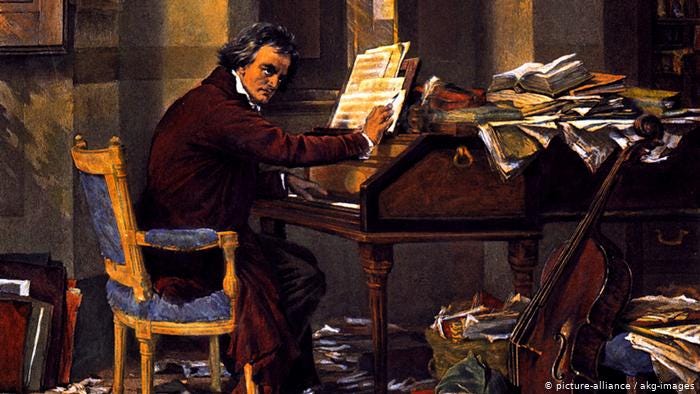
If Beethoven’s symphonies are his public pronouncements, his piano sonatas are his personal diary. And the last three sonatas, of which this is the first, are the most intimate and private pages.
Beethoven began composing his Piano Sonata №30 in 1820. The lilting, falling water music that begins the movement is one of the most inviting and enveloping musical moments that I know. However, Beethoven quickly morphs this theme into many different moods and expression, from ecstasy to anger. The second movement feels and sounds like a dramatic outburst of the first and is just a couple of minutes long. In fact, the first two movements combined last less than half the time of the final movement. The third and final movement is one of the great theme and variations ever written, equaling Bach’s Goldberg Variations in its profound scope and cyclical nature. It is not known if this sonata was ever performed in Beethoven’s lifetime. However, Franz Liszt started performing it as early as 1830
With Beethoven’s music, we are blessed with transcendent recordings and performances. I’m going to suggest that you first, however, listen to this extraordinary lecture on this sonata by the great András Schiff.
http://download.guardian.co.uk/sys-audio/Arts/Culture/2006/12/20/01-30emajop109.mp3
Schiff’s live performance of this sonata is such a great example of his remarkable mind, equal parts musician and philosopher, producing an extraordinary interpretation.
My wildcard pick for my favorite available recordings is one that is, indeed, difficult to find, yet is luckily still on Spotify. The period instrument specialist, Paul Komen, recorded five volumes of Beethoven’s sonatas on the small label, Globe. I’m assuming that this was unfortunately an aborted attempt at a complete sonata set. It’s revelatory to hear these sonatas played with such clarity and attention to detail.
Dame Myra Hess was a towering figure in the first half of the twentieth century, particularly in England, where her WWII lunchtime concerts which started during The Blitz and lasted for six years, reached over a 800,000 people. She organized over 2000 concerts and played in 150 of them. For this remarkable achievement, King George VI named her a Dame Commander of the Order of the British Empire in 1941. Here is her famous 1953 recording of this sonata, without doubt one of the greatest ever made.
The first recording of the complete sonatas was made by the great Arthus Schnabel. Of the historical recordings other than Hess’s, this is one that I’ve always loved.
Another great interpreter of the music of Beethoven was Claudio Arrau. We are lucky to have three complete sets that he recorded over his very long career. Here is a phenomenal live performance, in excellent sound and beautiful black and white film, from Paris in 1970.
Certainly, one of the most persuasive pianists of the 20th century, regardless of the repertoire,was Sviatoslav Richter. He had a remarkable relationship with the last three sonatas throughout his career and here a fascinating video from 1991.
Whenever a new complete set is completed, there is always the unfortunate and unnecessary question of, is this the best one ever recorded? Every great pianist has attributes that I admire but, for me, the complete set that has been recorded in modern times that speaks to me is by Stephen Kovacevich, and his Sonata №30 is particularly compelling.
